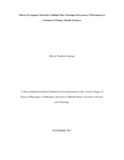| dc.contributor.author | Sulungai, Metrine Wambani | |
| dc.contributor.author | EDM/H/01/11 | |
| dc.date.accessioned | 2017-11-23T08:45:54Z | |
| dc.date.available | 2017-11-23T08:45:54Z | |
| dc.date.issued | 2017-11 | |
| dc.identifier.uri | http://r-library.mmust.ac.ke/123456789/267 | |
| dc.description | THESIS | en_US |
| dc.description.abstract | Studies attribute poor performance in mathematics especially in fractions in public primary
schools to teacher centred teaching methods. However, few researchers have tried out
interventions based on computer interactive multiple mice technique that promises to offer
interactive and collaborative learning benefits enabling learners in resource-constrained
schools to share one computer each with their own mouse. The purpose of this study was to
investigate effects of computer interactive multiple mice technique on learners’ achievement,
motivation and classroom interaction in learning fractions in public primary schools. The
study was guided by the following objectives: to determine any difference in achievement
between learners’ taught using computer interactive multiple mice technique and those taught
using conventional instructional methods, to find out any difference in motivation between
learners’ taught using computer interactive multiple mice technique and those taught using
conventional instructional methods and to establish any difference in classroom interaction
between learners’ taught using computer interactive multiple mice and those taught using
conventional instructional methods. Computer Support for Collaborative Learning theory was
used to depict the relationship between computer interactive multiple mice technique and
conventional instructional methods as the independent variables and learners’ performance as
the dependent variable. The study adopted quasi experimental pre-test, post-test, non
equivalent groups design. The target population was 5,487 Standard 6 learners in public
primary co-educational schools in Kenya. A sample of 518 learners from 12 schools were
selected. Sampling techniques used involved stratification, purposive and simple randomized
sampling. Computer interactive multiple mice technique was used in the experimental group
while conventional instructional method was used in the control groups. Two Mathematics
Achievement Tests (Mathematics Achievement Test 1 and Mathematics Achievement Test 2)
gauged learners’ achievement in fractions. Mathematics Achievement Test 1 was used as a
pretest for the two groups. Mathematics Achievement Test 2 was used to determine learner
achievement after instruction. Mathematics Lesson Observation Checklist (MLOC) was used
to gauge learners’ classroom interactions. Learner Motivation Questionnaire (LMQ) was used
to determine learners’ motivation towards learning fractions. The instruments were piloted in
two public primary co-educational schools of Hamisi Sub County. Face and content validity
were determined by experts in mathematics subject. Test retest reliability method was
deployed. Reliability was established using Pearson’s Product Moment of Correlation
Coefficient to determine if the instruments were reliable. Class observations was employed to
provide comparative findings to supplement the quantitative data. To test the hypotheses,
inferential statistics (t-test) were used at significance level of .05. Qualitative data was
summarized using descriptive statistics (frequencies, percentages, mean and standard
deviation) and presented using tables and figures. A response rate of 89.1% (476) was
realized. The findings revealed that on the pretest, the two groups were comparable. The
posttest revealed significant difference with mean performance of the experimental group
higher than the control group. The findings revealed significant difference in achievement
between the groups (t474 = 21.925, p = .000.), improved mean scores in motivation and
enhanced classroom interactions. Therefore, computer interactive multiple mice technique
enhanced learners achievement in fractions, improved learner motivation and enhanced
classroom interaction as compared to conventional instructional methods in public primary
schools of Hamisi Sub County. | en_US |
| dc.description.sponsorship | School of Education | en_US |
| dc.publisher | MMUST | en_US |
| dc.subject | Ministry of Education Science and Technology | en_US |
| dc.subject | National Assessment Centre | en_US |
| dc.subject | National Assessment of Education Progress | en_US |
| dc.subject | Strengthening of Mathematics and Science Education | en_US |
| dc.subject | International Mathematics | en_US |
| dc.subject | Non Governmental Organization | en_US |
| dc.subject | Content Knowledge Model | en_US |
| dc.subject | Computer Interactive Multiple Mice Technique | en_US |
| dc.title | Effects of Computer Interactive Multiple Mice Technique On Learners’ Performance in Fractions In Primary Schools In Kenya | en_US |

